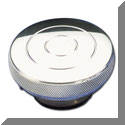* That's correct, pure Antifreeze moves the freezing
temperature higher! The minimum freezing temperature is achieved with a
60% antifreeze in water solution.
 Therefore
why use anything but water? Several reasons. First the use of
antifreeze prevents freezing! However 33% antifreeze will allow the engine
to get to 0 degrees F, low enough for us in the South. As noted above,
even a 50/50 mix only raises the boiling point 11 degrees! But in places
in the engine we can easily get higher than that. That is why we use a
pressure cap! A 15 psi cap is typical and the Billet Specialties 15 psi
cap (pictured) is what is being used on the '34. At 15 psi pressure
the boiling point of water will rise to 250 deg! Using 33% antifreeze will
raise the boiling point to about 260 deg F. That should be sufficient for
most street rod applications.
Therefore
why use anything but water? Several reasons. First the use of
antifreeze prevents freezing! However 33% antifreeze will allow the engine
to get to 0 degrees F, low enough for us in the South. As noted above,
even a 50/50 mix only raises the boiling point 11 degrees! But in places
in the engine we can easily get higher than that. That is why we use a
pressure cap! A 15 psi cap is typical and the Billet Specialties 15 psi
cap (pictured) is what is being used on the '34. At 15 psi pressure
the boiling point of water will rise to 250 deg! Using 33% antifreeze will
raise the boiling point to about 260 deg F. That should be sufficient for
most street rod applications.
Thermostat
After trying a few types, a 180 deg Robershaw Hi Flow works
fine. It takes longer to warm up than the standard 185 but is somewhat
better on very hot days when idling.
Additives
Both Redline "Water Wetter" and "40 Below" additives have
been used. Saw no benefit to the more expensive "40 Below" over "Water
Wetter."
Since a 33% antifreeze mixture is used, the reduced corrosion
properties of "Water Wetter" are worth the fairly low cost. Even though
some published information indicates it doesn't offer and advantage (re. the
Griffin Web Site), under conditions where the temperature raises creating
possible localized boiling, it may be a benefit. Have not found either
additive significantly reduced the temperature rise on hot days while idling.
The Red Line "Water Wetter" information on their web site is also compelling!
Used the new Prestone 5 yr/100,000 mile universal product
since it has more corrosion inhibitors and "sounds" like it could be better for
the cast iron block, aluminum heads and rad. Added some "Water
Wetter" as well.
This Site:
We're "hitchhiking" on our commercial web site to bring you
this information on 1934 Street Rod If you or a friend have a
MIG Welder (also called a Wire Welder, GMAW, etc) visit our site on How To Save
Shielding Gas Waste. You can reduce the number of times and the effort required
to have your shielding gas cylinder filled in half!
Just click HERE. You can return
to this site by using the Links at the bottom of the
"CAR BUFFS"
page.
$ave money and get better weld
starts!
If you make a lot of short welds and weld tacks you can
probably reduce your gas usage by 50% or more. Also fewer trips to have
the cylinder filled.
Note:
Thanks to those "Car Crazy" folks who have purchased
the Gas Saver System and commented on the improved starts and reduced gas usage
they have achieved. Many purchased our 6 foot prefitted
GSS,
Part Number WAT FB6 or you may want our 3
and 4 foot prefittted
GSS,
Part Number FB3, FB4
►GSS
PRODUCTS
RETURN TO "KEEP COOL" MAIN PAGE